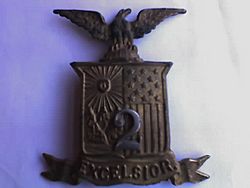Excelsior Brigade facts for kids
Quick facts for kids Excelsior Brigade (2nd Brigade) |
|
|---|---|

The insignia of the Excelsior Brigade
|
|
| Active | 1861 – 1864 |
| Allegiance | Union Army |
| Type | Brigade |
| Size | 4 - 6 regiments |
| Part of | Army of the Potomac
|
| Nickname(s) | Excelsior Brigade |
| Engagements | American Civil War |
| Commanders | |
| Notable commanders |
Daniel E. Sickles William R. Brewster |
The Excelsior Brigade was a special group of soldiers in the Union Army during the American Civil War. Most of these soldiers came from New York and were put together by Daniel Sickles, who used to be a politician. This brigade fought in many big battles, like Chancellorsville and Gettysburg.
Contents
Forming the Brigade: Early Days
When the Civil War began, Daniel Sickles wanted to help. He worked hard to gather thousands of new soldiers from around New York City in May 1861. The first groups of soldiers he organized joined the army on June 20, 1861.
Sickles was made a colonel of one of the four main groups he put together. Later, in September 1861, he became a brigadier general and took charge of the entire brigade.
Who Was in the Excelsior Brigade?
The first four groups of soldiers in the Excelsior Brigade were from New York. They were the 70th, 72nd, 73rd, and 74th New York Infantry.
In October 1861, the 71st New York joined them. Also, ten companies of the 3rd Indiana Cavalry became part of the brigade. General Sickles led this larger group.
First Missions and Challenges
The brigade was placed under the command of Maj. Gen. Joseph Hooker. Their first jobs were to help build defenses around Washington, D.C. They also worked to stop supplies from reaching the Confederate soldiers from Southern Maryland.
In March 1862, Sickles had to step down from his command for a short time. But he worked hard using his political connections in Washington. He got his rank and command back on May 24, 1862. This meant he could rejoin the army for the Peninsula Campaign.
Because of this break, he missed his brigade's actions at the Battle of Williamsburg. However, Sickles was back in charge for the Battle of Seven Pines and the Seven Days Battles.
Battles and Changes in Leadership
On June 25, at the Battle of Oak Grove, Sickles's New York soldiers faced difficulties. They struggled to move through obstacles and a swamp. They also met strong Confederate resistance, which made their battle line uneven.
Sickles was not present for the Second Battle of Bull Run. He had taken leave to recruit more troops in New York City. During this time, Colonel Nelson Taylor led the brigade instead.
The Excelsior Brigade, still led by Colonel Taylor, missed the Battle of Antietam in September. This was because the III Corps was protecting the capital along the lower Potomac River.
The brigade grew stronger with the addition of the 120th New York. In the Battle of Fredericksburg, Colonel George B. Hall led the Excelsiors.
Brigadier General Joseph W. Revere commanded the Excelsior Brigade during the Battle of Chancellorsville in early May 1863. The brigade was kept in reserve near the Chancellor House. They guarded a road that led to an important river crossing.
The Gettysburg Campaign: A Major Test
After the Battle of Chancellorsville, Colonel William R. Brewster of the 73rd New York took command. The Excelsior Brigade was then part of Brigadier General Andrew A. Humphreys's division. Brewster led the brigade during the Gettysburg Campaign in June and July 1863.
Fighting at Gettysburg
On July 2, the brigade moved forward to an area near the Peach Orchard. Confederate soldiers, led by Major General Lafayette McLaws, attacked their side. This forced the brigade to move out of their position.
Later that afternoon, the remaining soldiers of the brigade took part in a counterattack. They managed to get back some Union cannons that had been left behind. Brewster reported that the brigade lost 778 out of 1,837 soldiers who fought.
After Gettysburg
Brewster became ill after the battle. Brigadier General Francis Barretto Spinola took command as the Union army chased the Confederate army into Virginia. Spinola's brigade led the Union troops on July 23 at the Battle of Wapping Heights in Linden, Virginia.
They lost 18 men, including two officers, and many more were wounded. Spinola himself was badly hurt in the fighting.
Colonel J. Egbert Farnum of the 70th New York then commanded the brigade. He led them until Brewster returned to duty for the autumn battles of 1863. Brewster inspired his men by leading them in the Mine Run Campaign, even though he was still recovering from his illness.
The End of the Brigade: 1864
In the spring of 1864, the Army of the Potomac was reorganized. This was for Lieutenant General Ulysses S. Grant's Overland Campaign. Brewster remained in command of the brigade.
The Excelsior Brigade was joined by the 11th Massachusetts and the 84th Pennsylvania. They fought in the Battle of the Wilderness as part of the Fourth Division, II Corps. This division was led by Brigadier General Gershom Mott.
When the remaining parts of the division became part of Major General David B. Birney's Third Division during the Battle of Spotsylvania, Brewster’s brigade became the division’s Fourth Brigade. He led these soldiers at the Battle of Cold Harbor and during the start of the Siege of Petersburg.
After these battles, the Excelsior Brigade was officially ended. Most of the Excelsior soldiers were moved to a different brigade. The individual groups of soldiers left the army during the summer of 1864. The men returned home to New York.
Images for kids



